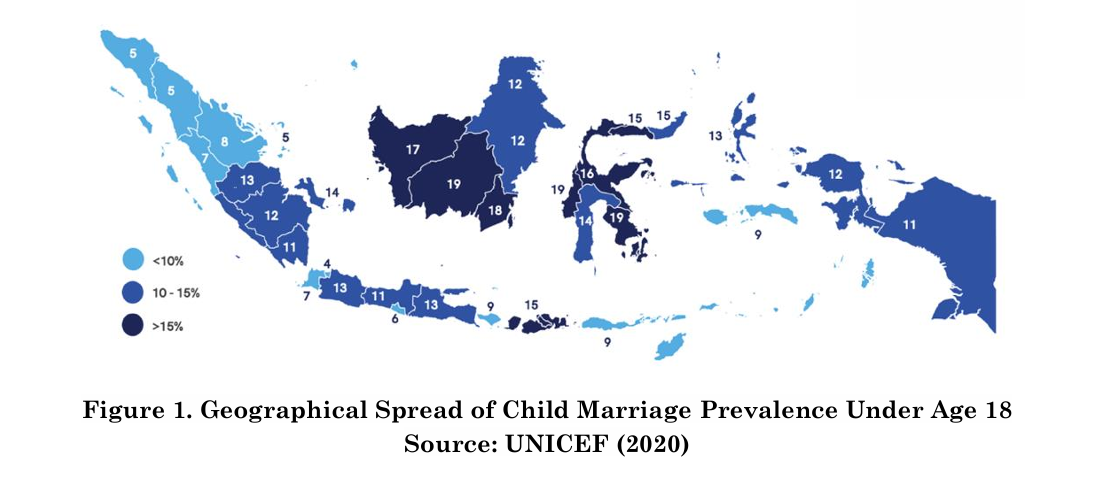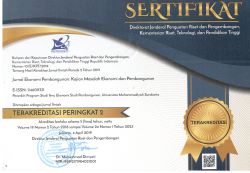Determinants of Food Insecurity: The Role of Child Marriage and Socioeconomic Factors in Indonesia
DOI:
https://doi.org/10.23917/jep.v26i1.11226Keywords:
Child marriage, Food insecurity, SUSENAS 2022, IndonesiaAbstract
This research aims to empirically analyze the impact of child marriage on household food insecurity using detailed microdata from Indonesia. Specifically, the study examines the relationship between age at marriage and various indicators of food insecurity, including food availability, access, and stability within households. Child marriage, defined as marriage before the age of 18, remains prevalent in many developing countries, including Indonesia. Early marriage often leads to early childbearing and increased dependency ratios, which can strain household resources and undermine food security. This study uses data from the 2022 National Socioeconomic Survey (SUSENAS), conducted by the Statistics Indonesia (BPS). The study classifies the research sample into three groups: (i) individuals who engaged in child marriage, (ii) women who engaged in child marriage, and (iii) men who engaged in child marriage. The results of the logit regression analysis show that child marriage is positively associated with household food insecurity. Moreover, the risk of food insecurity tends to be greater among men who marry as children compared to women in similar circumstances, even after controlling for socioeconomic factors. By providing empirical evidence on how child marriage contributes to household food insecurity, the findings of this study can inform targeted policies and interventions to address both child marriage and food insecurity, thereby promoting improved socioeconomic outcomes for affected households.
Downloads
References
Adams, E. L., Caccavale, L. J., Smith, D., & Bean, M. K. (2020). Food Insecurity, the Home Food Environment, and Parent Feeding Practices in the Era of COVID-19. Obesity, 28(11), 2056–2063. https://doi.org/10.1002/oby.22996
Aditya, R. I., & Waddington, L. (2021). The Legal Protection Against Child Marriage in Indonesia. Bestuur, 9(2), 126–134. https://doi.org/10.20961/bestuur.v9i2.55144
Amalina, D., Pratomo, D., & Pangestuty, F. (2023). The role of working mothers and mothers’ education in children’s education during the COVID-19 pandemic in Indonesia. International Journal of Adolescence and Youth, 28. https://doi.org/10.1080/02673843.2023.2242464
Ashby, S., Kleve, S., McKechnie, R., & Palermo, C. (2016). Measurement of the dimensions of food insecurity in developed countries: A systematic literature review. In Public Health Nutrition (Vol. 19, Issue 16, pp. 2887–2896). Cambridge University Press. https://doi.org/10.1017/S1368980016001166
Ayuandini, S., Habito, M., Ellis, S., Kennedy, E., Akiyama, M., Binder, G., Nanwani, S., Sitanggang, M., Budiono, N., Ramly, A. A., Humphries-Waa, K., Azzopardi, P. S., & Hennegan, J. (2023). Contemporary pathways to adolescent pregnancy in Indonesia: A qualitative investigation with adolescent girls in West Java and Central Sulawesi. PLOS Global Public Health, 3(10), e0001700-. https://doi.org/10.1371/journal.pgph.0001700
Baraie, B., Rezaei, M., Nadrian, H., & Matlabi, H. (2023). What Socio-Cultural Factors Encourage Child Marriage in Sanandaj, Iran? A Qualitative Study. Child & Youth Services, 45. https://doi.org/10.1080/0145935X.2023.2167708
Bartels, S. A., Michael, S., & Bunting, A. (2021). Child Marriage among Syrian Refugees in Lebanon: At the Gendered Intersection of Poverty, Immigration, and Safety. Journal of Immigrant and Refugee Studies, 19(4), 472–487. https://doi.org/10.1080/15562948.2020.1839619
Becker, G. S. (1964). Human Capital: A Theoretical and Empirical Analysis, with Special Reference to Education. University of Chicago Press.
Béné, C., Bakker, D., Chavarro, M. J., Even, B., Melo, J., & Sonneveld, A. (2021). Global assessment of the impacts of COVID-19 on food security. Global Food Security, 31, 100575. https://doi.org/https://doi.org/10.1016/j.gfs.2021.100575
Berkowitz, S. A., Seligman, H. K., Meigs, J. B., & Basu, S. (2018). Food Insecurity, Healthcare Utilization, and High Cost: A Longitudinal Cohort Study HHS Public Access. In Am J Manag Care (Vol. 24, Issue 9).
Berry, E. M. (2020). Food Insecurity, Social Inequity, and Sustainability. World Review of Nutrition and Dietetics, 121, 95–104. https://doi.org/10.1159/000507489
Brander, M., Bernauer, T., & Huss, M. (2021). Improved on-farm storage reduces seasonal food insecurity of smallholder farmer households – Evidence from a randomized control trial in Tanzania. Food Policy, 98. https://doi.org/10.1016/j.foodpol.2020.101891
Browning, M. (1998). Efficient Intra-Household Allocations: A General Characterization and Empirical Tests. Econometrica, 66, 1241–1278. https://doi.org/10.2307/2999616
Cameron, L., Contreras Suarez, D., & Wieczkiewicz, S. (2023). Child marriage: using the Indonesian family life survey to examine the lives of women and men who married at an early age. Review of Economics of the Household, 21(3), 725–756. https://doi.org/10.1007/s11150-022-09616-8
Carpena, F., & Jensenius, F. (2019). Age of Marriage and Women’s Political Engagement: Evidence from India. SSRN Electronic Journal. https://doi.org/10.2139/ssrn.3383080
Efevbera, Y., & Bhabha, J. (2020). Defining and deconstructing girl child marriage and applications to global public health. In BMC Public Health (Vol. 20, Issue 1). BioMed Central Ltd. https://doi.org/10.1186/s12889-020-09545-0
Enakhe, O. B., & Tamuno, S. (2021). Poverty, Unemployment and Food Insecurity: Empirical Evidence from Nigeria. Asian Journal of Economics, Business and Accounting, 107–123. https://doi.org/10.9734/ajeba/2021/v21i630395
Fan, S., & Koski, A. (2022a). The health consequences of child marriage: a systematic review of the evidence. BMC Public Health, 22(1). https://doi.org/10.1186/s12889-022-12707-x
Fan, S., & Koski, A. (2022b). The health consequences of child marriage: a systematic review of the evidence. BMC Public Health, 22(1), 309. https://doi.org/10.1186/s12889-022-12707-x
FAO, OFAD, UNICEF, WFP, & WHO. (2023). The State of Food Security and Nutrition in the World 2023. In The State of Food Security and Nutrition in the World 2023. FAO; IFAD; UNICEF; WFP; WHO. https://doi.org/10.4060/cc3017en
Gallegos, D., Eivers, A., Sondergeld, P., & Pattinson, C. (2021). Food insecurity and child development: A state-of-the-art review. In International Journal of Environmental Research and Public Health (Vol. 18, Issue 17). MDPI. https://doi.org/10.3390/ijerph18178990
Gambir, K., Matsika, A. B., Panagiotou, A., Snowden, E., Lofthouse, C., & Metzler, J. (2024). Associations between child marriage and food insecurity in Zimbabwe: a participatory mixed methods study. BMC Public Health, 24(1). https://doi.org/10.1186/s12889-023-17408-7
Gujarati, D. N. (2003). Basic Econometrics (4th ed.). McGraw-Hill Higher Education. www.mhhe.com
Hasegawa, T., Sakurai, G., Fujimori, S., Takahashi, K., Hijioka, Y., & Masui, T. (2021). Extreme climate events increase risk of global food insecurity and adaptation needs. Nature Food, 2(8), 587–595. https://doi.org/10.1038/s43016-021-00335-4
Heponiemi, T., Jormanainen, V., Leemann, L., Manderbacka, K., Aalto, A.-M., & Hyppönen, H. (2020). Digital Divide in Perceived Benefits of Online Health Care and Social Welfare Services: National Cross-Sectional Survey Study. Journal of Medical Internet Research, 22(7). https://doi.org/https://doi.org/10.2196/17616
International Center for Research on Women (ICRW). (2017). The economic impacts of child marriage: Global synthesis brief. https://www.icrw.org/wp-content/uploads/2018/02/ICRW_Brief_GlobalSynthesis.pdf
Judiasih, S. D. (2020). Kontradiksi antara dispensasi kawin dengan upaya meminimalisir perkawinan bawah umur di indonesia. Jurnal Ilmu Hukum Kenotariatan Fakultas Hukum Unpad, 3.
Kansiime, M. K., Tambo, J. A., Mugambi, I., Bundi, M., Kara, A., & Owuor, C. (2021). COVID-19 implications on household income and food security in Kenya and Uganda: Findings from a rapid assessment. World Development, 137. https://doi.org/10.1016/j.worlddev.2020.105199
Kara, A. M., & Kithu, L. (2020). Education attainment of head of household and household food security: A case for Yatta sub-county, Kenya. American Journal of Educational Research, 8(8), 558–566. https://doi.org/10.12691/education-8-8-7
Kent, K., Murray, S., Penrose, B., Auckland, S., Visentin, D., Godrich, S., & Lester, E. (2020). Prevalence and socio-demographic predictors of food insecurity in Australia during the COVID-19 pandemic. Nutrients, 12(9), 1–20. https://doi.org/10.3390/nu12092682
Kousar, S., Ahmed, F., Pervaiz, A., & Bojnec, Š. (2021). Food insecurity, population growth, urbanization and water availability: The role of government stability. Sustainability (Switzerland), 13(22). https://doi.org/10.3390/su132212336
Ma, W., Nie, P., Zhang, P., & Renwick, A. (2020). Impact of Internet use on economic well‐being of rural households: Evidence from China. Review of Development Economics, 24, 503–523. https://doi.org/10.1111/rode.12645
Martinez, E. (2021). Food Insecurity Amid the COVID-19 Lockdowns in Nigeria: Do Impacts on Food Insecurity Persist After Lockdowns End? Current Developments in Nutrition, 5, 235. https://doi.org/10.1093/cdn/nzab029_036
Mohajan, H. (2022). Food Insecurity and Malnutrition of Africa: A Combined Attempt Can Reduce Them. Journal of Economic Development, Environment and People, 11, 2022. https://doi.org/10.26458/jedep.v1i1.716
Mosadeghrad, A. M., Gebru, A. A., Sari, A. A., & Tafesse, T. B. (2019). Impact of food insecurity and malnutrition on the burden of Non-communicable diseases and death in Ethiopia: A situational analysis. Human Antibodies, 27(4), 213–220. https://doi.org/10.3233/HAB-190369
Msuya, N. H. (2020). Child marriage: An obstacle to socio-economic development in sub-Saharan Africa. Journal for Juridical Science, 45(2). https://doi.org/10.18820/24150517/jjs45.i2.2
Nguyen, M. C., & Wodon, Q. (2014). Impact of child marriage on literacy and education attainment in Africa. http://allinschool.org/wp-content/uploads/2015/02/ OOSC-2014-QW-Child-Marriage-final.pdf
Nour, N. (2009). Child Marriage: A Silent Health and Human Rights Issue. Reviews in Obstetrics and Gynecology, 2, 51–56.
Nove, A., Matthews, Z., Neal, S., & Camacho, A. V. (2014). Maternal mortality in adolescents compared with women of other ages: evidence from 144 countries. The Lancet Global Health, 2(3), e155–e164. https://doi.org/10.1016/S2214-109X(13)70179-7
Olarewaju, O. (2021). Insecurity in northern Nigeria: Implications for maternal and child health. Clinical Epidemiology and Global Health, 12, 100869. https://doi.org/10.1016/j.cegh.2021.100869
Paul, P. (2020). Child marriage among girls in India: Prevalence, trends and socio-economic correlates. Indian Journal of Human Development, 14(2), 304–319. https://doi.org/10.1177/0973703020950263
Penne, T., & Goedemé, T. (2020). Can low-income households afford a healthy diet? Insufficient income as a driver of food insecurity in Europe. Food Policy, 99. https://doi.org/10.1016/j.foodpol.2020.101978
Polsky, J., & Garriguet, D. (2022). Household food insecurity in Canada early in the COVID-19 pandemic. Health Reports, 33, 15–26. https://doi.org/10.25318/82-003-x202200200002-eng
Pourmotabbed, A., Moradi, S., Babaei, A., Ghavami, A., Mohammadi, H., Jalili, C., Symonds, M. E., & Miraghajani, M. (2020). Food insecurity and mental health: A systematic review and meta-analysis. In Public Health Nutrition (Vol. 23, Issue 10, pp. 1778–1790). Cambridge University Press. https://doi.org/10.1017/S136898001900435X
Pourtaheri, A., Sany, S. B. T., Aghaee, M. A., Ahangari, H., & Peyman, N. (2023). Prevalence and factors associated with child marriage, a systematic review. BMC Women’s Health, 23(1), 531. https://doi.org/10.1186/s12905-023-02634-3
Psaki, S. R., Melnikas, A. J., Haque, E., Saul, G., Misunas, C., Patel, S. K., Ngo, T., & Amin, S. (2021). What are the drivers of child marriage? A conceptual framework to guide policies and programs. Journal of Adolescent Health, 69(6), S13–S22. https://doi.org/10.1016/j.jadohealth.2021.09.001
Scott, S., Nguyen, P. H., Neupane, S., Pramanik, P., Nanda, P., Bhutta, Z. A., Afsana, K., & Menon, P. (2021). Early marriage and early childbearing in South Asia: trends, inequalities, and drivers from 2005 to 2018. Annals of the New York Academy of Sciences, 1491(1), 60–73. https://doi.org/https://doi.org/10.1111/nyas.14531
Shankar, P., Chung, R., & Frank, D. (2017). Association of food insecurity with children’s behavioral, emotional, and academic outcomes: A systematic review. Journal of Developmental and Behavioral Pediatrics : JDBP, 38. https://doi.org/10.1097/DBP.0000000000000383
Sisha, T. A. (2020). Household level food insecurity assessment: Evidence from panel data, Ethiopia. Scientific African, 7. https://doi.org/10.1016/j.sciaf.2019.e00262
Sjahrir, B. S., & Wibisono, I. D. (2021). Food insecurity in Indonesia during the COVID-19 pandemic: What do we learn from the high-frequency monitoring of households? https://documents1.worldbank.org/curated/en/099815001042352934/pdf/P17567408b656a0a00afcd0d1f3912dad66.pdf
Soler-Hampejsek, E., Kangwana, B., Austrian, K., Amin, S., & Psaki, S. (2021). Education, child marriage, and work outcomes among young people in rural Malawi. Journal of Adolescent Health, 69, S57–S64. https://doi.org/10.1016/j.jadohealth.2021.09.011
UNICEF. (2020). Child Marriage in Indonesia. UNICEF. https://www.unicef.org/indonesia/reports/child-marriage-in-indonesia
UNICEF. (2021). Towards ending child marriage: Global trends and profiles of progress.
UNICEF. (2023). Understanding pathways to adolescent pregnancy in South East Asia: Findings from Indonesia. UNFPA Asia Pacific Regional Office and UNICEF East Asia and Pacific Regional Office. https://www.unicef.org/eap/media/14161/file/UNICEF.pdf
United Nations. (2023). The cost of child marriage over the life cycle of girls and women Evidence from Egypt, Iraq, Jordan and Tunisia. ESCWA, United Nations House. Lebanon. https://www.unicef.org/mena/media/23986/file/The%20cost%20of%20child%20marriage%20over%20the%20life%20cycle%20of%20girls%20and%20women.pdf.

Submitted
Accepted
Published
How to Cite
Issue
Section
License
Copyright (c) 2025 Firdaus Finuliyah, Axellina Muara Setyanti, Mohammad Khusaini, Arif Rosyidi

This work is licensed under a Creative Commons Attribution 4.0 International License.













